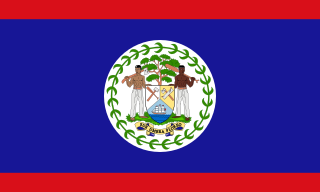
Belize is a Caribbean and Central American country on the north-eastern coast of Central America. It is bordered by Mexico to the north, the Caribbean Sea to the east, and Guatemala to the west and south. It also shares a water boundary with Honduras to the southeast. It has an area of 22,970 square kilometres (8,867 sq mi) and a population of 441,471 (2022). Its mainland is about 290 km (180 mi) long and 110 km (68 mi) wide. It is the least populated and least densely populated country in Central America. Its population growth rate of 1.87% per year is the second-highest in the region and one of the highest in the Western Hemisphere. Its capital is Belmopan, and its largest city is the namesake city of Belize City. Belize is often thought of as a Caribbean country in Central America because it has a history similar to that of English-speaking Caribbean nations. Indeed, Belize’s institutions and official language reflect its history as a British colony.

Central America is a subregion of the Americas. Its boundaries are defined as bordering Mexico to the north, Colombia to the south, the Caribbean Sea to the east, and the Pacific Ocean to the west. Central America consists of seven countries: Belize, Costa Rica, El Salvador, Guatemala, Honduras, Nicaragua, and Panama. Within Central America is the Mesoamerican biodiversity hotspot, which extends from northern Guatemala to central Panama. Due to the presence of several active geologic faults and the Central America Volcanic Arc, there is a high amount of seismic activity in the region, such as volcanic eruptions and earthquakes which has resulted in death, injury, and property damage.

Orange Walk District is a district in the northwest of the nation of Belize, with its district capital in Orange Walk Town.
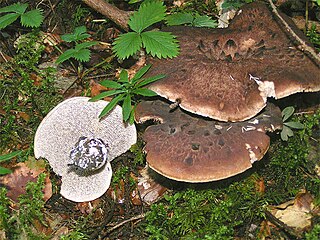
The Thelephorales are an order of fungi in the class Agaricomycetes. The order includes corticioid and hydnoid fungi, together with a few polypores and clavarioid species. Most fungi within the Thelephorales are ectomycorrhizal. None is of any great economic importance, though Sarcodon imbricatus is edible and commercially marketed, whilst several species have been used for craft dyeing.
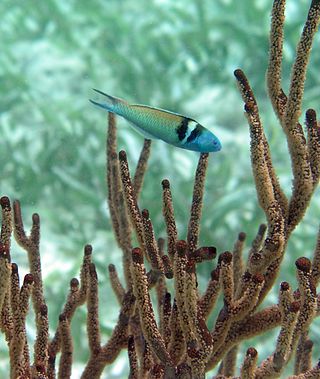
Since declaring independence in 1981, Belize has enacted many environmental protection laws aimed at the preservation of the country's natural and cultural heritage, as well as its wealth of natural resources. These acts have established a number of different types of protected areas, with each category having its own set of regulations dictating public access, resource extraction, land use and ownership.

Sarcodon imbricatus, commonly known as the shingled hedgehog or scaly hedgehog, is a species of tooth fungus in the order Thelephorales. The mushroom is edible. Many sources report it has a bitter taste, but others have found it delicious and suspect that the bitter specimens may be similar related species. The mushroom has a large, brownish cap with large brown scales and may reach 30 cm (12 in) in diameter. On the underside it sports greyish, brittle teeth instead of gills, and has white flesh. Its spore print is brown. It is associated with spruce (Picea), appearing in autumn. It ranges throughout North America and Europe, although collections from the British Isles are now assigned to the similar species Sarcodon squamosus.

Sarcodon is a genus of fungi in the family Bankeraceae, which is part of the order Thelephorales known for its almost universal ectomycorrhizal life style. The genus owes its name to the presence of teeth-like spines on the hymenophore, it is derived from ancient Greek; sarco = flesh and odon = tooth. This is why they are commonly called "tooth fungi", or "Hydnoid fungi".

Visitors to Belize require a visa unless they come from one of the visa-exempt countries. All visitors are required to have sufficient funds, US$75 per day, and documents required for their next destination.

Sarcodon atroviridis is a species of fungus in the family Bankeraceae found in North America and Asia. It was originally described in 1895 as Hydnum atroviride by Andrew Price Morgan. Howard James Banker transferred it to Sarcodon in 1906. The fungus is known from Asia and North America; in 2015 it was reported from Brazil. The specific epithet atroviridis means "blackish green". While not explicitly known to be poisonous, it is considered of poor edibility.
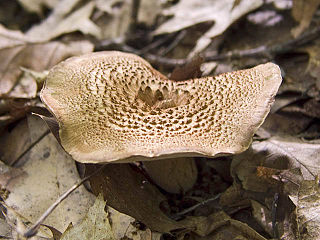
Hydnellum underwoodii is an inedible species of tooth fungus in the family Bankeraceae. Found in North America, it was described as new to science in 1906 by American mycologist Howard James Banker. Its reddish-brown, convex to flattened cap measures 5–14 cm (2.0–5.5 in) in diameter. Reddish-brown, partially erect scales adorn the cap surface. Spines on the cap underside are 1–3 mm long; they are initially white, becoming brown with grayish tips in age. The oval to spherical spores are 6–7.5 by 5.5–6.5 µm. The fungus fruits singly or scattered, on the ground in coniferous forests.
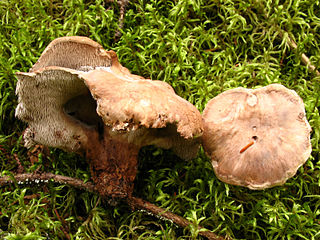
Sarcodon stereosarcinon is a species of tooth fungus in the family Bankeraceae. Found in North America, it was described as new to science in 1940 by mycologist Lewis Edgar Wehmeyer, who found the original collections in Nova Scotia, Canada.
Sarcodon quercophilus is a species of tooth fungus in the family Bankeraceae. Found in Belize, where it grows on the ground in mountainous cloud forest under oak, it was described as new to science in 2015.
Sarcodon portoricensis is a species of tooth fungus in the family Bankeraceae. Found in Puerto Rico, where it grows on clay soils of low-elevation wet forests, it was described as new to science in 2015.
Sarcodon pakaraimensis is a species of tooth fungus in the family Bankeraceae. Found in Guyana, where it grows in mixed Pakaraimaea–Dicymbe forest, it was described as new to science in 2015. It is differentiated from other Sarcodon species by its smooth to pitted, pinkish-gray cap that stains black, its hollow stipe, and the pink staining reaction of injured flesh. Its spores measure 5–7 µm long by 5–9 µm wide. They make a fresh dark reddish-brown spore print, which tends to lighten to yellowish brown when it is dry. Molecular analysis of DNA sequences shows the fungus to be closely related to S. umbilicatus. The specific epithet pakaraimensis refers to the Pakaraima Mountains—the type locality.

Lighthouse Reef is an atoll in the Caribbean Sea, the easternmost part of the Belize Barrier Reef and one of its three atolls, the other two being Turneffe Atoll and Glover's Reef. Lighthouse Reef is located about 80 kilometres (50 mi) southeast of Belize City. The atoll is of oblong shape, approximately 35 kilometres (22 mi) long from north to south, and about 8 kilometres (5.0 mi) wide. It forms a shallow sandy lagoon with an area of 120 square kilometres (46 sq mi) and a depth between 2 to 6 metres deep.
Sarcodon quercinofibulatus is a species of tooth fungus in the family Bankeraceae. Found in Spain, where it grows under Quercus petraea, it was described as new to science in 2011. The thick, fleshy caps of its fruit bodies are up to 14 cm (5.5 in) in diameter. The cap cuticle breaks up in age into concentric brown scales, revealing the cream-coloured brown flesh underneath. Spines on the underside of the cap are 5–8 mm long. They are initially cream, but become gray to grayish-brown in maturity. Application of a solution of potassium hydroxide turns the flesh grayish-green. The spores of S. quercinofibulatus are spherical, or nearly so, and typically measure 6.5–7.4 by 5.4–6.4 µm.
Sarcodon wrightii is a species of tooth fungus in the family Bankeraceae. It was first described in 1860 by Miles Berkeley and Moses Ashley Curtis as Hydnum wrightii. They were sent a specimen collected from Japan as part of the North Pacific Exploring and Surveying Expedition (1853–56). Rudolph Arnold Maas Geesteranus transferred it to the genus Sarcodon in 1967. The fungus produces roughly spherical spores that are tuberculate and measure 5.5–6.5 by 4.5–5.5 μm.

Sarcodon thwaitesii is a species of tooth fungus in the family Bankeraceae. It is found in Asia, Europe, and New Zealand, where it fruits on the ground in mixed forest.
Sarcodon scabripes is a species of fungus in the family Bankeraceae found in Asia, Europe, and North America. It was originally described in 1897 as Hydnum scabripes by Charles Horton Peck. Howard James Banker transferred it to the genus Sarcodon in 1906. The fungus makes fruit bodies with a drab gray to flesh-colored cap, and flesh that is white. In addition to the United States, where it was first documented, S. scabripes has been reported from Japan and the Sverdlovsk Oblast region of Russia.
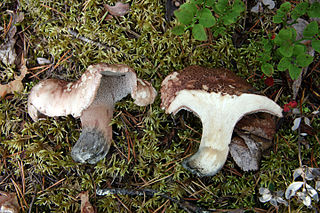
Hydnellum scabrosum, also called bitter tooth or bitter hedgehog, is a species of tooth fungus in the family Bankeraceae.













